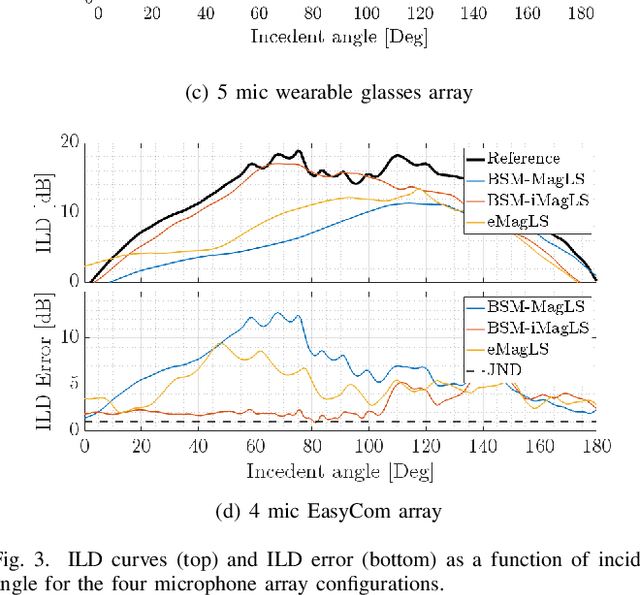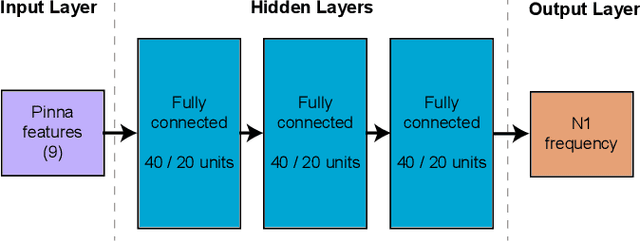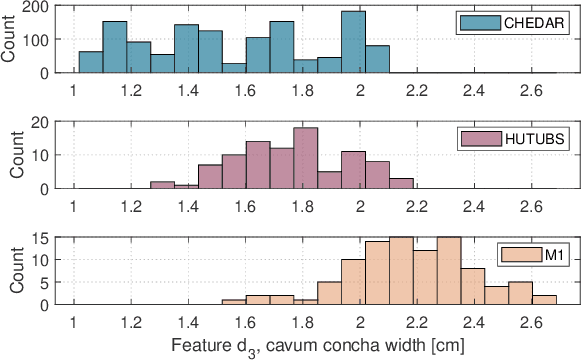David Lou Alon
BSM-iMagLS: ILD Informed Binaural Signal Matching for Reproduction with Head-Mounted Microphone Arrays
Jan 30, 2025



Abstract:Headphone listening in applications such as augmented and virtual reality (AR and VR) relies on high-quality spatial audio to ensure immersion, making accurate binaural reproduction a critical component. As capture devices, wearable arrays with only a few microphones with irregular arrangement face challenges in achieving a reproduction quality comparable to that of arrays with a large number of microphones. Binaural signal matching (BSM) has recently been presented as a signal-independent approach for generating high-quality binaural signal using only a few microphones, which is further improved using magnitude-least squares (MagLS) optimization at high frequencies. This paper extends BSM with MagLS by introducing interaural level difference (ILD) into the MagLS, integrated into BSM (BSM-iMagLS). Using a deep neural network (DNN)-based solver, BSM-iMagLS achieves joint optimization of magnitude, ILD, and magnitude derivatives, improving spatial fidelity. Performance is validated through theoretical analysis, numerical simulations with diverse HRTFs and head-mounted array geometries, and listening experiments, demonstrating a substantial reduction in ILD errors while maintaining comparable magnitude accuracy to state-of-the-art solutions. The results highlight the potential of BSM-iMagLS to enhance binaural reproduction for wearable and portable devices.
Assessing the Potential Impact of Direction-Dependent HRTF Selection on Sound Localization Accuracy
Aug 08, 2024Abstract:This study investigates the approach of direction-dependent selection of Head-Related Transfer Functions (HRTFs) and its impact on sound localization accuracy. For applications such as virtual reality (VR) and teleconferencing, obtaining individualized HRTFs can be beneficial yet challenging, the objective of this work is therefore to assess whether incorporating HRTFs in a direction-dependent manner could improve localization precision without the need to obtain individualized HRTFs. A localization experiment conducted with a VR headset assessed localization errors, comparing an overall best HRTF from a set, against selecting the best HRTF based on average performance in each direction. The results demonstrate a substantial improvement in elevation localization error with the method motivated by direction-dependent HRTF selection, while revealing insignificant differences in azimuth errors.
Feasibility of iMagLS-BSM -- ILD Informed Binaural Signal Matching with Arbitrary Microphone Arrays
Aug 07, 2024

Abstract:Binaural reproduction for headphone-centric listening has become a focal point in ongoing research, particularly within the realm of advancing technologies such as augmented and virtual reality (AR and VR). The demand for high-quality spatial audio in these applications is essential to uphold a seamless sense of immersion. However, challenges arise from wearable recording devices equipped with only a limited number of microphones and irregular microphone placements due to design constraints. These factors contribute to limited reproduction quality compared to reference signals captured by high-order microphone arrays. This paper introduces a novel optimization loss tailored for a beamforming-based, signal-independent binaural reproduction scheme. This method, named iMagLS-BSM incorporates an interaural level difference (ILD) error term into the previously proposed binaural signal matching (BSM) magnitude least squares (MagLS) rendering loss for lateral plane angles. The method leverages nonlinear programming to minimize the introduced loss. Preliminary results show a substantial reduction in ILD error, while maintaining a binaural magnitude error comparable to that achieved with a MagLS BSM solution. These findings hold promise for enhancing the overall spatial quality of resultant binaural signals.
On HRTF Notch Frequency Prediction Using Anthropometric Features and Neural Networks
Mar 12, 2024



Abstract:High fidelity spatial audio often performs better when produced using a personalized head-related transfer function (HRTF). However, the direct acquisition of HRTFs is cumbersome and requires specialized equipment. Thus, many personalization methods estimate HRTF features from easily obtained anthropometric features of the pinna, head, and torso. The first HRTF notch frequency (N1) is known to be a dominant feature in elevation localization, and thus a useful feature for HRTF personalization. This paper describes the prediction of N1 frequency from pinna anthropometry using a neural model. Prediction is performed separately on three databases, both simulated and measured, and then by domain mixing in-between the databases. The model successfully predicts N1 frequency for individual databases and by domain mixing between some databases. Prediction errors are better or comparable to those previously reported, showing significant improvement when acquired over a large database and with a larger output range.
iMagLS: Interaural Level Difference with Magnitude Least-Squares Loss for Optimized First-Order Head-Related Transfer Function
Nov 28, 2023Abstract:Binaural reproduction for headphone-based listening is an active research area due to its widespread use in evolving technologies such as augmented and virtual reality (AR and VR). On the one hand, these applications demand high quality spatial audio perception to preserve the sense of immersion. On the other hand, recording devices may only have a few microphones, leading to low-order representations such as first-order Ambisonics (FOA). However, first-order Ambisonics leads to limited externalization and spatial resolution. In this paper, a novel head-related transfer function (HRTF) preprocessing optimization loss is proposed, and is minimized using nonlinear programming. The new method, denoted iMagLS, involves the introduction of an interaural level difference (ILD) error term to the now widely used MagLS optimization loss for the lateral plane angles. Results indicate that the ILD error could be substantially reduced, while the HRTF magnitude error remains similar to that obtained with MagLS. These results could prove beneficial to the overall spatial quality of first-order Ambisonics, while other reproduction methods could also benefit from considering this modified loss.
 Add to Chrome
Add to Chrome Add to Firefox
Add to Firefox Add to Edge
Add to Edge